How to Draw Cool Spaceship
Designing spaceships for games is a fun feel. If yous're interested in 3D fine art (opens in new tab), science, exploration and the common cold, haunting darkness of space then yous should definitely give it a attempt.
Designing a spaceship for a game is a dissimilar challenge compared to illustrating a scene. You accept to consider all distances and directions of view, likewise as ensuring that your pattern fits into the game'southward world.
- How to describe: 95 tutorials for drawing animals, people, landscapes and more (opens in new tab)
In many science fiction games the spaceship is a character in itself, and this is a good way to approach the topic. Is your ship brand spanking new, or a beaten-up bucket of bolts? Are the owners rich or poor? How nearly calculation unique elements that suggest it'southward a semi-sentient craft, or a plant-based bioship? Perhaps the ship's been created from a hollowed-out asteroid to look inconspicuous?
Thinking of your spaceship design in the same fashion as your characters volition help you to create an interesting ship that people tin can relate to and desire to fly in the game.
01. Answering the brief's requirements
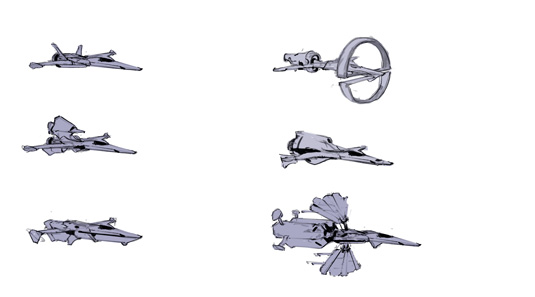
I'm going to design a fast sentinel ship that'south able to defend itself and rescue colonists under threat. Defining your universe'southward technology volition shape your design. Every bit an instance, what's the propulsion engineering science? A fast, fuel-intensive method would mean less space for supplies. Perhaps information technology's achieved with a specific drive that takes up more room than conventional engines?
02. Thumbnailing designs

In a game that features a range of ships, it's crucial that they have distinctive silhouettes. Think about basic design language: for case, rounded edges can exist seen every bit condom shapes, then use them for passenger crafts.
My thumbnails fit the brief because their flat undersides would be able to handle planetary re-entry. The wings convey manoeuvrability and speed.
03. Mood check
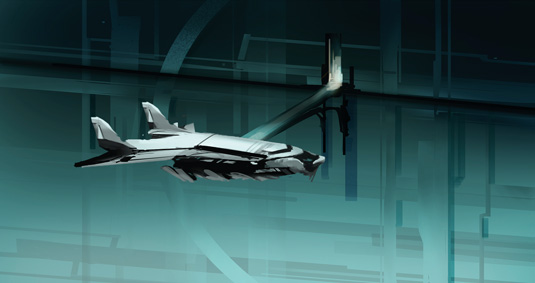
Once I've completed the thumbnails I take my favourite ones further. I drop them speedily into more appropriate surroundings, such as this elementary space dock.
This helps requite me a amend sense of what my ships will look similar in-game. If I already take some other ships created for this game and then I sit them alongside each other for comparison.
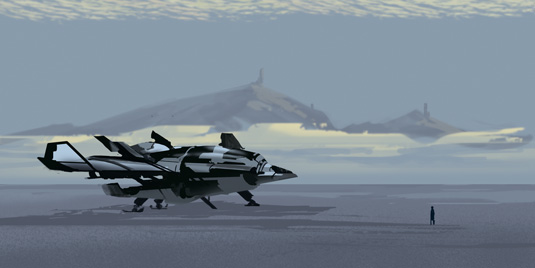
A handy trick often used in car design that volition help you make your work await more plausible is to add some of the footing's color into the underside of your spaceship and some of the sky's colour to the top.
Typically, this would exist brownish and blueish, respectively. But yous tin use whatsoever you think fits your spaceship and its surroundings.
04. Refining thumbnails
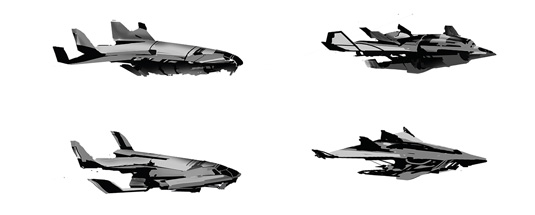
At this stage I can usually tell what areas I want to focus on. I work up my favoured thumbnails, taking them in slightly different directions and seeing if I like the results.
I still attempt and keep the amount of tones I apply to a minimum. The spaceship is going to exist under a lot of lighting conditions in-game, then I desire it to piece of work in all of them, and making sure it reads like this helps.
05. Developing clean line work
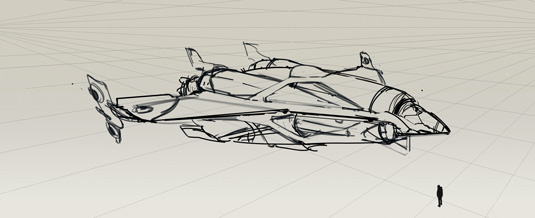
I chose this thumbnail because information technology fits the brief. I imagine that the flat underside is able to enter the temper safely, the wings indicate that this is a highly manoeuvrable craft, while its chunky body alludes to a cargo-based function. I feel the ship is at one time small enough to atomic number 82 on to some bigger ships later in the game, while big enough to feature offensive weaponry.
I accept the pattern into a new certificate and commencement sketching out the linework. Doing this on a perspective grid avoids issues later on. I throw in a figure to give the 3D modellers an idea of scale.
06. Tone block-in
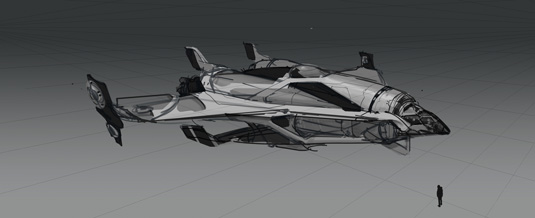
Adjacent I block out the basic tones of the send. For gaming purposes you take to retrieve about what areas of the bodywork might be customisable. This could exist either equally simple every bit adding a decal, or something more complex such as applying a new colour scheme equally chosen past the player.
07. Colouring the craft
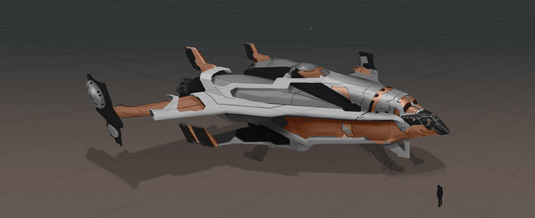
My view of color is that it's an important tool for breaking up the panels and giving more life to my pattern. If your game has faction colours then now's a good time to add them in – it'll help establish its place in your gaming universe.
08. Refining your blueprint
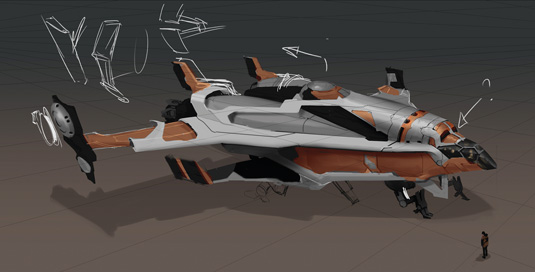
Don't exist afraid to question your pattern. Here I've experimented with the fly shapes, and left myself trivial visual prompts. Your design will go along throwing up new challenges to resolve, and so continue looking at existent-life reference.
A top tip is to draw your perspective line with the Path tools, then y'all don't have to worry about going off canvas. Start select the Path tool. Then select the Line tool and fix the Pixel Width to 1. Create a new path and describe your horizontal line with vanishing points at either end.
You can also create a new layer and use the Stroke Path tool to bring these perspective lines to the canvass. Don't forget that you can choose the colour of your stroke paths – it will simulate whichever castor and colour you've picked.
x. Landing gear
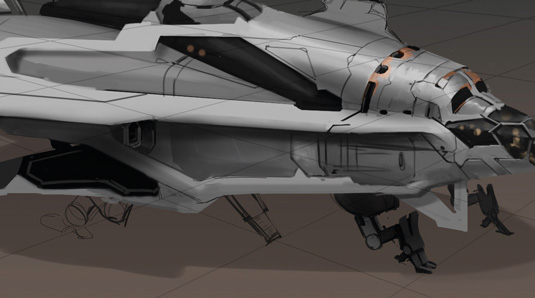
The transport is going to need to land, and the crew will probably desire the ability to become out! I add doors and landing gear to my ship design; I don't want to have to squeeze these elements in after someone has started to turn my drawing into a 3D model.
xi. Weathering design elements
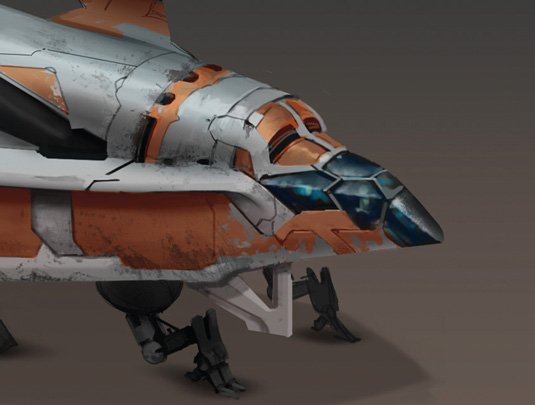
I add together weathering to my designs. This helps sell what the ship's life is similar, enriches the game world and gives everything a sense of depth. Think nearly how a transport could experience wearable and tear.
An asteroid miner might be covered in dust and small dents. A long-distance goods freighter could characteristic mismatched trunk panels, with worn pigment piece of work around cargo doors.
12. A modular approach
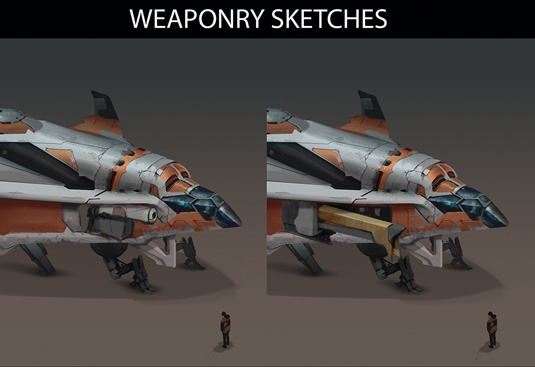
I ensure that the craft I've designed will fit in with the current game mechanics by dropping in some weaponry that I've chop-chop concepted. Modular parts such every bit amend engines or a long-altitude scanner gives the players something to aim for, in terms of in-game achievements.
13. Articulate labelling
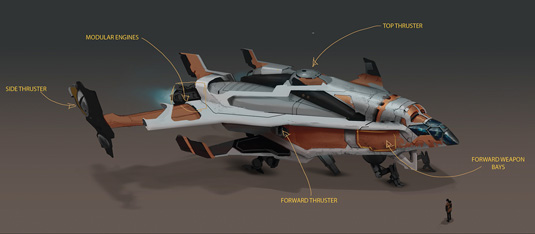
In the games industry a grouping of artists further downwards the production pipeline volition be turning your concept into a 3-dimensional model.
For the best translation of your idea – and to avoid lots of emails going back and along – yous should explain your fine art as much as possible, as simply and clearly as possible. Here I label where I recollect moving and modular parts should become.
14. Produce an orthographic sketch
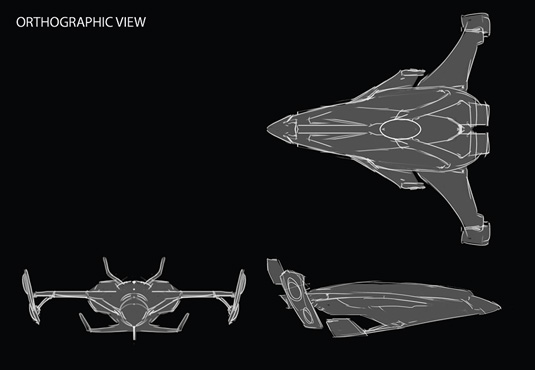
Once I'm happy with the beauty render, I'll send this to the 3D modellers along with an orthographic sketch of the basic forms from a variety of angles. Yet adept your concept might seem from one angle, someone else's view of it might exist completely different. Your sleek spaceship might come back looking similar a duck. We've all been there!
This commodity originally appeared in ImagineFX (opens in new tab) issue 115.
Related manufactures:
- Modelling a spaceship for gameplay design (opens in new tab)
- The v greatest CG spaceships ever (opens in new tab)
- Acuminate your hard-surface modelling (opens in new tab)
Source: https://www.creativebloq.com/sci-fi/video-game-spaceship-design-21619331